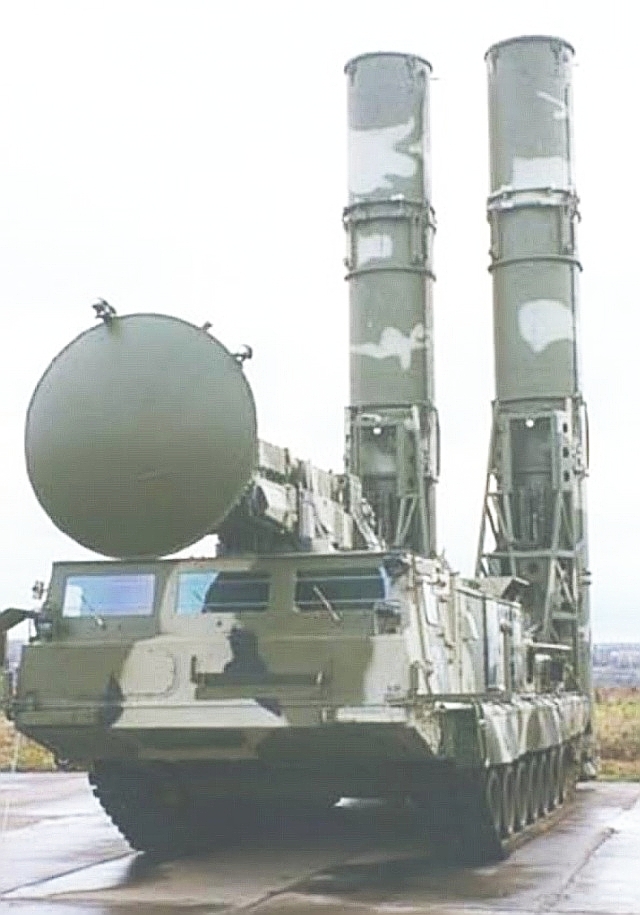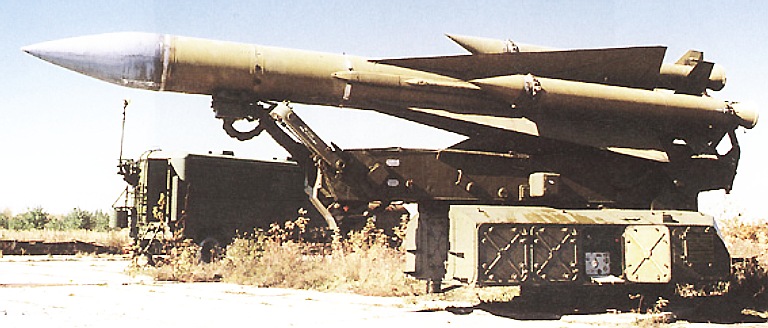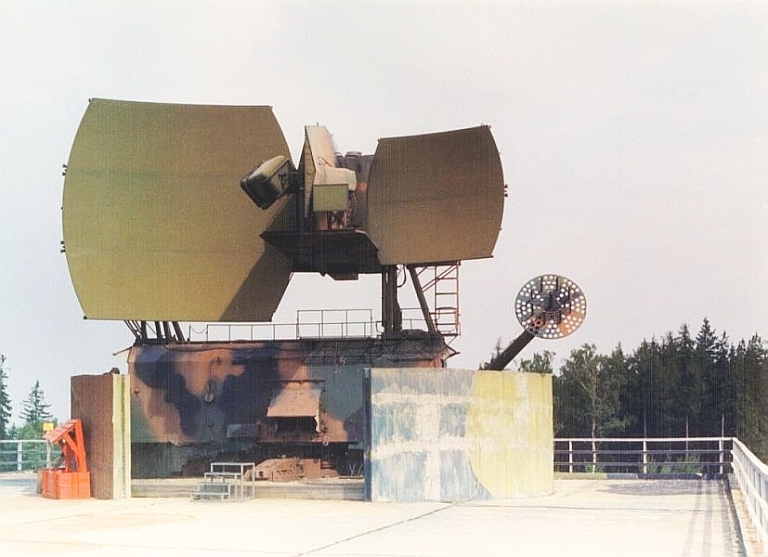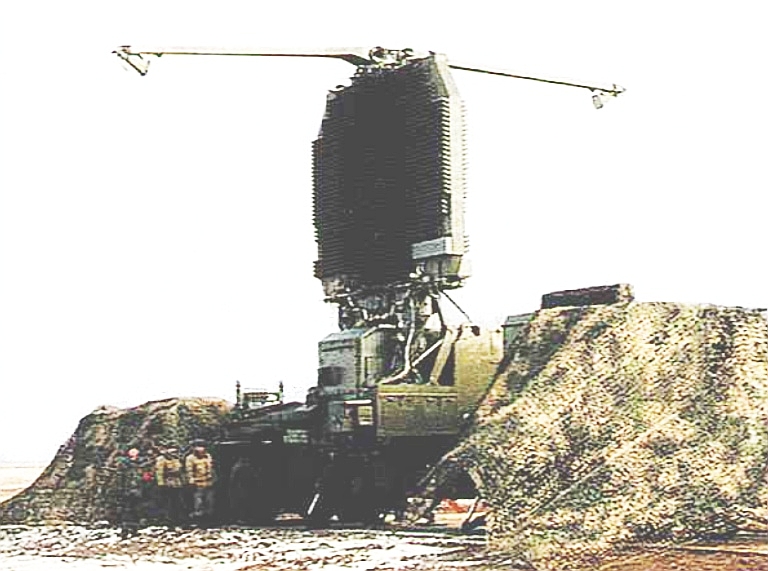|
||||||||||||||||||||||
![Home - Air Power Australia Website [Click for more ...]](APA/APA-Title-Main.png) |
||||||||||||||||||||||
![Sukhoi PAK-FA and Flanker Index Page [Click for more ...]](APA/flanker.png) |
![F-35 Joint Strike Fighter Index Page [Click for more ...]](APA/jsf.png) |
![Weapons Technology Index Page [Click for more ...]](APA/weps.png) |
![News and Media Related Material Index Page [Click for more ...]](APA/media.png) |
|||||||||||||||||||
![Surface to Air Missile Systems / Integrated Air Defence Systems Index Page [Click for more ...]](APA/sams-iads.png) |
![Ballistic Missiles and Missile Defence Page [Click for more ...]](APA/msls-bmd.png) |
![Air Power and National Military Strategy Index Page [Click for more ...]](APA/strategy.png) |
![Military Aviation Historical Topics Index Page [Click for more ...]](APA/history.png)
|
![Intelligence, Surveillance and Reconnaissance and Network Centric Warfare Index Page [Click for more ...]](APA/isr-ncw.png) |
![Information Warfare / Operations and Electronic Warfare Index Page [Click for more ...]](APA/iw.png) |
![Systems and Basic Technology Index Page [Click for more ...]](APA/technology.png) |
![Related Links Index Page [Click for more ...]](APA/links.png) |
|||||||||||||||
![Homepage of Australia's First Online Journal Covering Air Power Issues (ISSN 1832-2433) [Click for more ...]](APA/apa-analyses.png) |
||||||||||||||||||||||
| Last Updated: Mon Jan 27 11:18:09 UTC 2014 | ||||||||||||||||||||||
|
||||||||||||||||||||||
Hard Kill Counter-ISR Programs
Technical Report APA-TR-2007-0707 |
| by
Dr Carlo Kopp, AFAIAA, SMIEEE, PEng July, 2007 Updated April, 2012 Text, Line Artwork © 2007 Carlo Kopp (Expanded and updated from Defence Today, November/December 2006) |
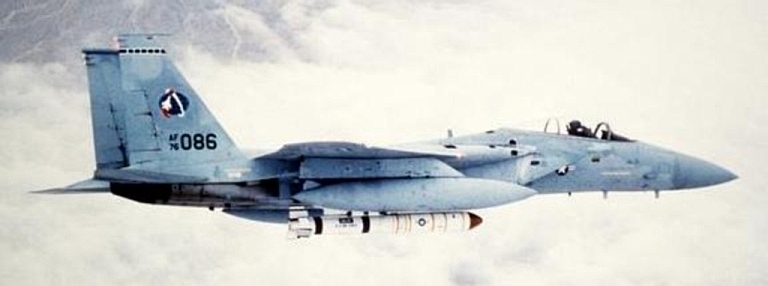 The
Vought
ASM-135A ASAT was the first air launched anti-satellite missile,
trialled during the mid 1980s.
Information is is the new 'high ground' in warfare. The current boom in Intelligence Surveillance Reconnaissance (ISR) capabilities is a byproduct of this basic change in focus, and in turn it is creating follow-on effects. Warfare being evolutionary in its nature, has resulted in the emergence of a range of new counter ISR capabilities, as nations confronted with Western ISR capabilities seek to even or reverse the odds. In a philosophical sense counter ISR capabilities are nothing particularly new. Camouflage and decoys were used extensively during World War II, as was jamming of radar, bombing of radar equipment, and interception of photoreconnaissance and electronic reconnaissance aircraft. These practices have continued ever since. What has evolved since then has been the technology of ISR, and more recently, the technology used to defeat ISR systems. Contemporary ISR is multi-pronged, involving radar ISR, optical ISR and passive electronic ISR sensors. These may be carried by fast jets, large airliner class transport airframes, satellites, or Unmanned Aerial Vehicles (UAV). A specific ISR system thus comprises a platform which carries an ISR payload, and may or may not be manned. The platfrom may be endo- or exo-atmospheric. Any system intended to defeat an ISR capability can be designed either as a system to defeat the ISR payload, or a system to destroy the platform carrying the ISR payload. A soft kill attack on an ISR system will most likely involve concealment of potential targets from the ISR payload sensors, or active jamming or blinding of the ISR payload sensors. A hard kill attack on an ISR system will most likely involve using a weapon to destroy the platform carrying the ISR payload. From an analysis perspective, any discussion of counter-ISR capabilities must encompass the full gamut of soft and hard kill techniques and tools. Hard Kill Counter ISR Capabilities Aiming to execute a hard kill against as ISR system can be the most expensive regime of attack, but also the most profitable, as the ISR payload and the platform will be destroyed if the attack is successful. With the exception of stealthy platforms, ISR sensor hardware is typically the most expensive hardware used in contemporary military systems. A good yardstick is that a typical ISR capable radar for a fighter aircraft costs between US$2.5M to US$12M apiece, a thermal imaging / laser targeting pod around US$3.5M, and a passive radio-frequency sensor payload up to tens of millions apiece. Conventional wisdom is that in current fighter aircraft the avionics payload, usually with some ISR capability, is worth 60% to 70% of the procurement cost of the system. As we from ISR capable combat aircraft to specialised ISR systems, this cost disparity grows. In extremis, a cheap UAV airframe may be worth 10% of the cost of a sophisticated ISR payload. The only mitigating factor is that increasing platform size or performance may offset ISR payload costs. For instance an electronic recce system like the RC-135V/W Rivet Joint or Proposed EP-8A ELINT/SIGINT system, may have a vehicle cost comparable to the payload cost, the same being true for AWACS/AEW&C or JSTARS like surveillance radar systems. For an attacker there is a very high payoff in the destruction of ISR systems. The payoff arises in two different ways. The first payoff is immediate and operational, as the victim loses the capacity to use ISR to maintain situational awareness. Shooting down an AWACS/AEW&C system denies radar/passive surveillance of airspace, shooting down an ELINT/SIGINT system denies surveillance of the radio-frequency spectrum, and shooting down a JSTARS/GMTI system denies surveillance of surface force movements. If this occurs at the beginning of a major battle, or while the battle is in progress, then the attacker may well have evened the odds, or if in possession of own ISR capabilities, gained a major advantage. The cardinal case studies are the air battle in progress, where one side destroys the other's AWACS/AEW&C system, or the land battle, where one side destroys the other's JSTARS/GMTI system. All else being equal, the side losing the major ISR system is apt to lose, and lose very rapidly. The second payoff to the attacker arises longer term, as major ISR assets are akin to the 'capital ships' of a past era, and are expensive to acquire and take a long time to build and deploy. Attrition of such high value assets cannot be sustained for very long, before the force using them becomes impotent. The rate at which such losses can be replenished is very slow, measured in years. Destruction of such assets represents both a significant economic loss to the victim, as well as a significant loss in operational potential. These effects remain true for smaller and less expensive ISR capabilities, with a diminishing scale of value and effect. Techniques for hard kill attacks on ISR assets vary widely, and depend on the type of platform used for the ISR system, and the potential loss to an attacker. 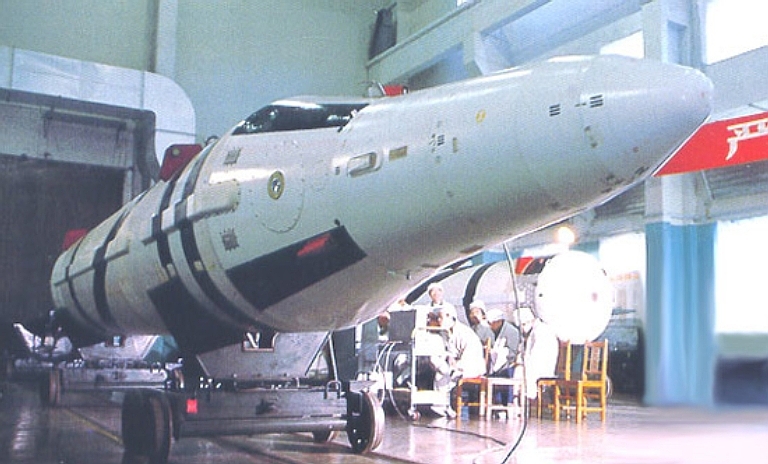 China's recent test of a direct ascent ASAT is believed to have involved a derivative of the JL-1/DF-21 missile, deployed as an SLBM and IRBM (PLA). 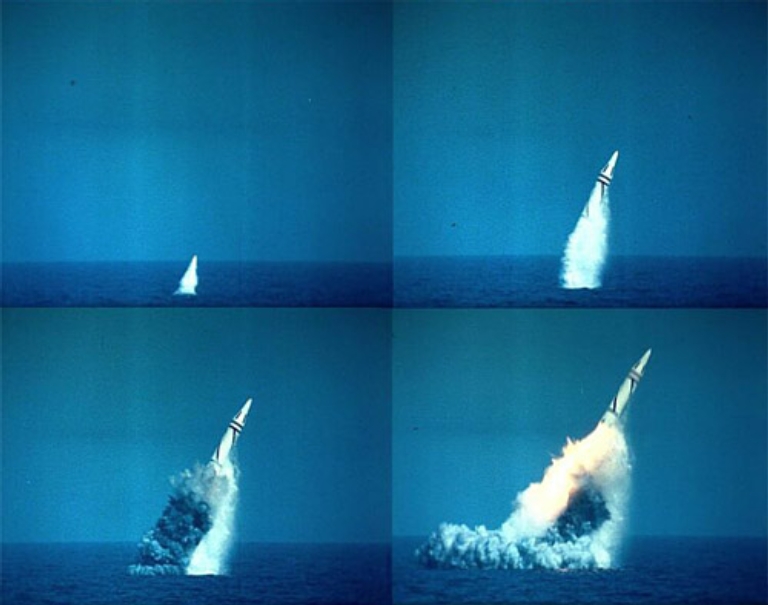 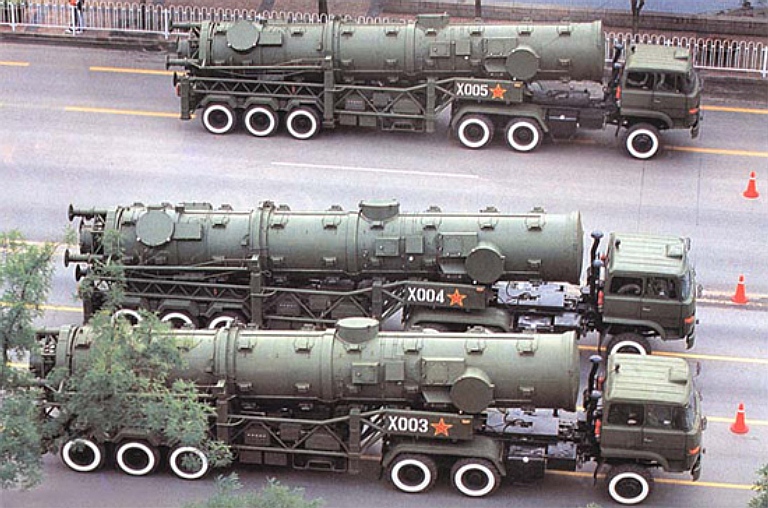 DF-21
IRBM TELs on parade in the PRC (Xinhua).
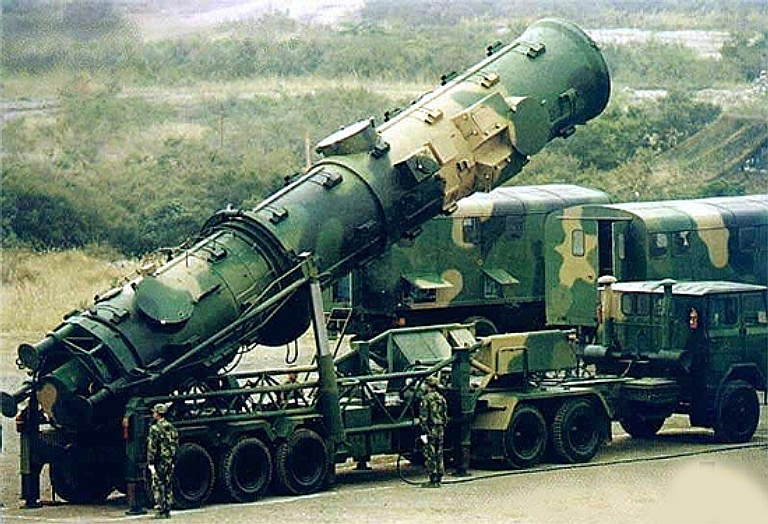 DF-21
IRBM TEL elevating into
missile launch position (PLA).
Hard Kill vs Satellites At the top of the kinematic game in ISR, and achievable surveillance footprints, are satellite ISR systems. These may be optical, infrared, or radar imaging satellites, or passive radio-frequency surveillance satellites. The largest and most capable such system are worth hundreds of millions apiece and may involve vehicles massing in excess of ten tonnes, flying in Low Earth Orbit (LEO) trajectories. Anti-satellite (ASAT) weapons come in three categories. Kinetic ASATs are either direct ascent weapons, or 'killer satellites' designed to match orbits, close with the target and destroy it, or multi-stage guided missiles, launched from high altitude in a zoom manoeuvre by an aircraft, using a guidance seeker to home to impact. At this time all categories are banned by treaty, and likely to remain so for the forseeable future. The fourth category of ASAT are Directed Energy Weapons (DEW) such as high power lasers, which at sufficiently high power levels can inflict thermal damage to the solar cells powering a satellite, or at even high power levels, directly damage the vehicle or its payload. Air Launched Counter ISR Weapons High flying UAVs and large ISR aircraft are the second category in the ISR heirarchy. The largest and most expensive of these assets compete with satellites in acquisition costs and lead times, and often in immediate surveillance footprints. Unlike LEO satellites, such systems have significant persistence. Three established strategies exist for destroying such ISR assets, both involving the use of guided missiles to attack the platform. 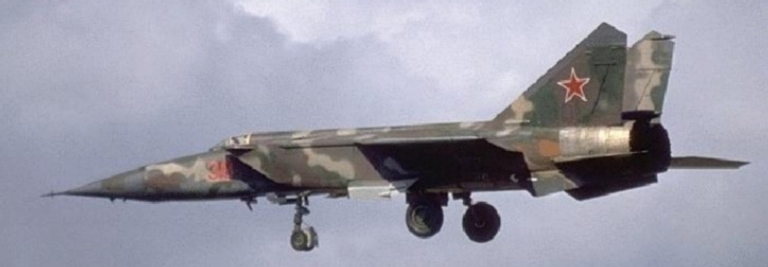 Foxbat F. The Soviet answer to the Wild Weasel F-4G, the Foxbat F is essentially a Foxbat D fitted with a radar homing system to support four AS-11 Kilter ARMs. The Kilter is comparable to HARM in size and performance, but lacks the sophistication of the HARM seeker. With high dash speeds the Foxbat F can punch through a CAP barrier and fire its ARMs before defending fighters can reengage, and in the high density European theatre envisaged in the eighties, it was a potentially very useful asset. 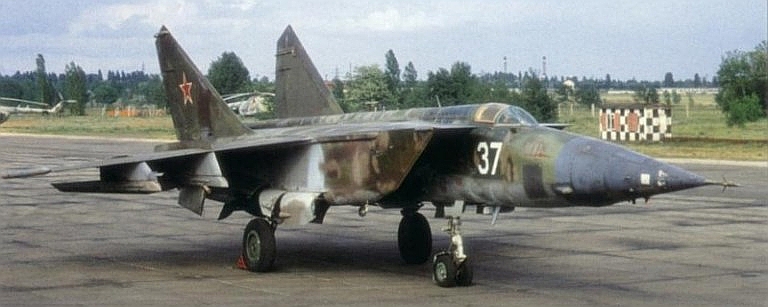 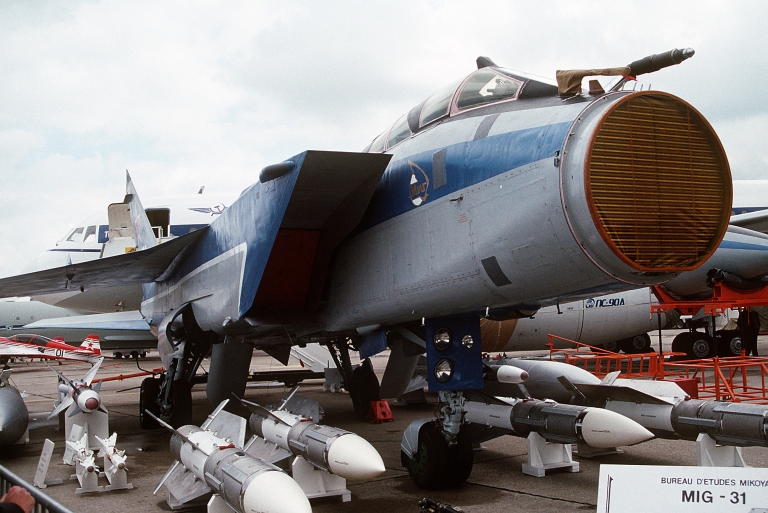 Foxhound: The Soviet follow-on to the Foxbat was the much more capable Foxhound, with a modern phased array air intercept radar. Below - MiG-31F demonstrator armed with R-37 / AA-13 Arrow. 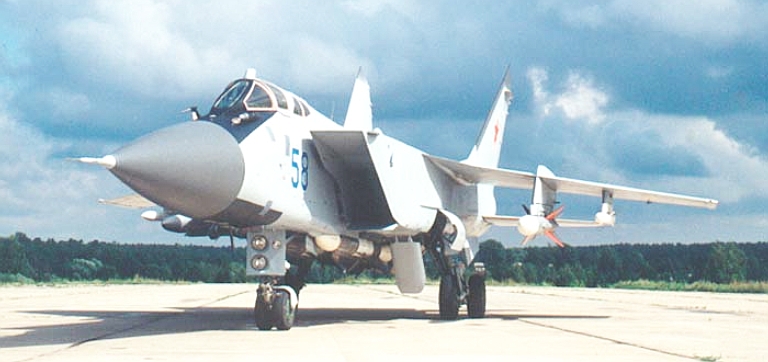 The first strategy is the 'conventional fighter attack' involving a high performance fighter and conventional air to air missiles. The Soviets pioneered this model during the 1980s, planning to use MiG-25BM Foxbat and MiG-31 Foxhound fighters in supersonic dashes across the NATO FEBA to kill AWACS and JSTARS. Even if several fighters are lost in such an attack, the payoff was considered justified. Soviet strategists were not happy with sacrificing expensive Foxbats and Foxhounds to kill even more expensive E-3, E-8 and RC-135V/W targets, and tasked Soviet design bureaus with a requirement for a very long range air to air missile, capable of killing ISR platforms, and tanker aircraft, from outside the range of opposing defences. 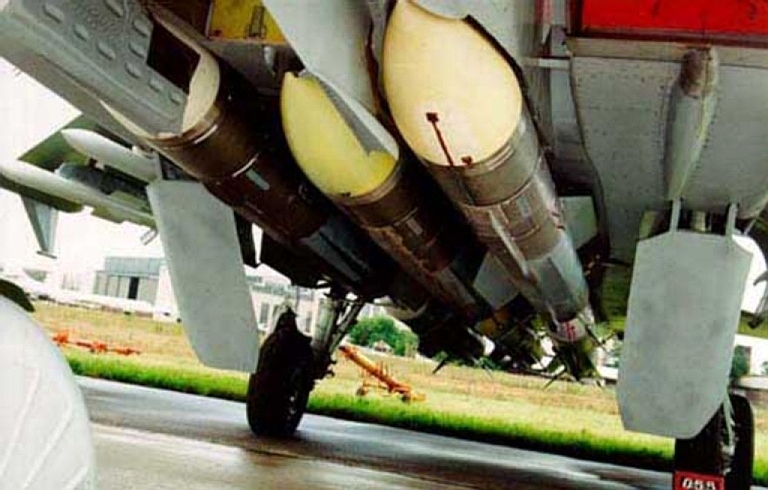 The Vympel R-37 / AA-13 Arrow was the first of the long range counter ISR missiles to emerge. It is equipped with an Agat 9B-1388 active radar seeker, and production variants are expected to be equipped with the new ARGS-PD seeker. 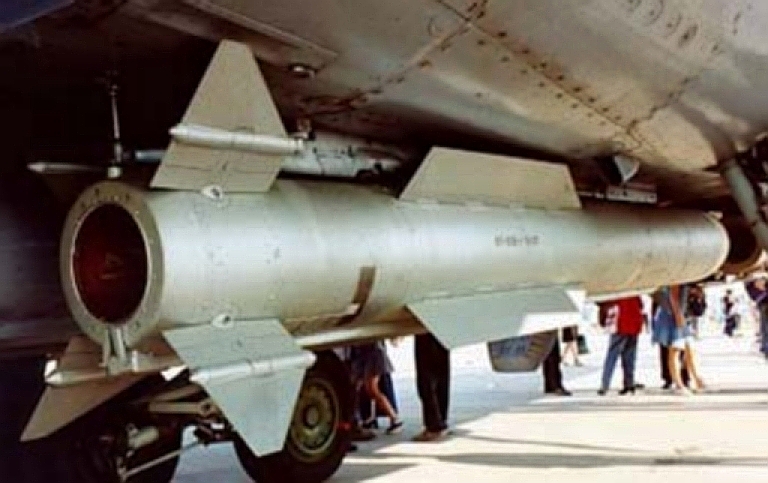 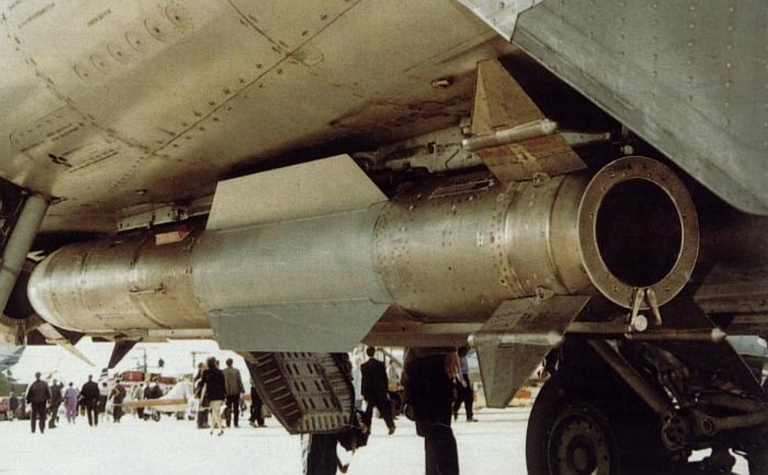 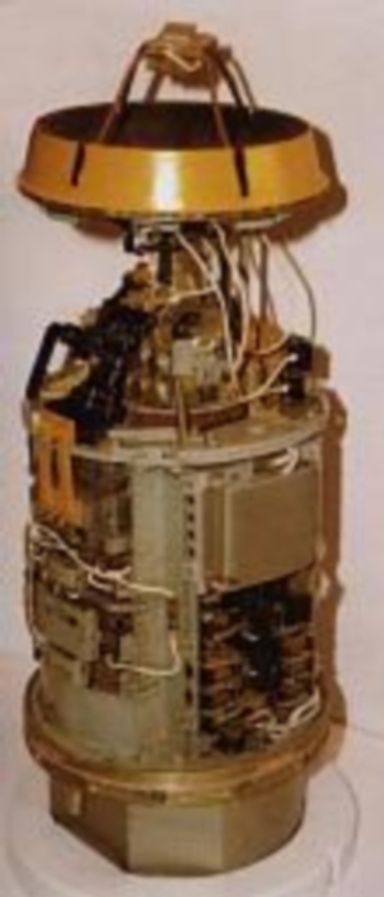 The result of this requirement was the Vympel R-37 (AA-X-13 Arrow) missile, an evolution of the technology in the AIM-54 Phoenix-like Vympel R-33 (AA-9 Amos) missile. The R-37 is designed to kill targets at 160 NMI (300 km) range, flying a climb/dive trajectory at high altitude, with a peak speed of around Mach 6. The missile uses large midbody strakes for enhanced lift, and folding cruciform tail controls for semiconformal carriage. The R-37 is equipped with an Agat 9B-1388RS active radar seeker, with midcourse inertial, data-link and semi-active radar homing capability. A datalink range of at least 100 km was disclosed. The seeker is claimed to be capable of acquiring a 5 square metre target at 21.5 NMI. Range performance varies with the flight profile, from 80 NMI for a direct shot, to a maximum of 215 NMI for a cruise glide profile. In 1994 a trial round killed a target at 162 NMI, a record for a BVR missile. While the R-37 was designed for carriage on the Su-27/30/35, MiG-29 and MiG-31, it was trialled on the MiG-31M Super Foxhound during the 1990s. Reports that the R-37 is to be now exported to Syria on the MiG-31E (BM) Foxhound indicate that production of the weapon has commenced. There are no reports as yet of integration on the Flanker, but given that Tikhomirov NIIP developed the radars for both the Foxhound and Flanker, integration will not present unusual obstacles. The Novator bureau, better known for the S-300V/SA-12 Gladiator/Giant long range SAMs and the 3M-54/SS-N-27 Sizzler cruise missile, soon followed with a competing proposal for the R-172 (formerly KS-172) AAM-L very long range missile. Like the R-37, the R-172 was developed as a counter ISR missile. The missile employs an active radar seeker and inertial midcourse guidance. Two configurations are known, with and without a booster pack. With the booster the missile is claimed to achieve a range of 215 NMI, without 160 NMI. Cited seeker performance is similar to the R-37. 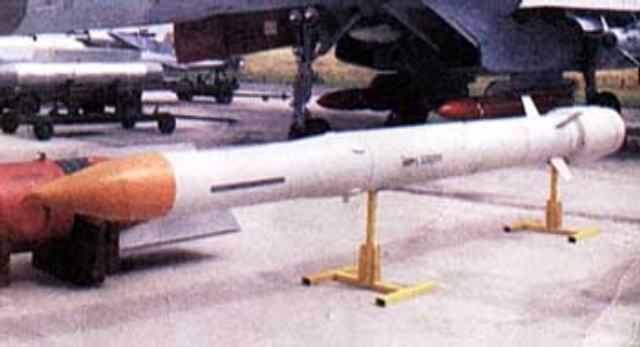 Recently redesignated the K-100/R-100, Novator's R-172 AAM-L followed the R-37 into development, and is available with a booster pack to extend its considerable range performance. 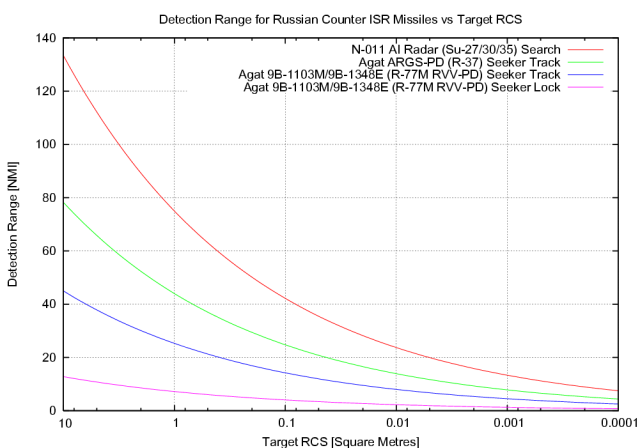 While the R-172 is less mature than the R-37, India's Defence Research and Development Organisation (DRDO) has recently been negotiating an arrangement to fund final development and licence produce the weapon, not unlike the established deal to licence the Yakhont as the BrahMos. The intention is to equip the Su-30MKI with the R-172 to defeat Pakistan's soon to be acquired Erieye AEW&C systems. It is reasonable to speculate that given the tit-for-tat arms purchase cycle between China and India, the PLA will in the near future actively pursue the R-37 to counter India's R-172. Smaller players will then follow suite. Agat announced in 2003 the development of a replacement seeker for the 9B-1388 series, the 11 inch diameter ARGS-PD, credited with a lock on range of 44 NMI, high power output, and lower weight. There is a view held in some circles that Russian counter-ISR missiles are of no concern, somehow, and that if need be attaching a jamming pod, or using a chaff or expendable jammer dispenser will render these weapons impotent. Reality is not that simple. Since the advent of the 9M9 missile, Russian designers have used jam resistant monopulse radar seekers where possible, and in a larger missile this does not present problems. Examination of photographs of the 9B-1388 antenna shows four coaxial feeds to the antenna, which proves it is indeed a monopulse design. Recent Agat seeker designs have used Texas Instruments TMS320 family digital signal processor chips, which would also be true of any late production variants of the 9B-1388 series. So the assumption that this large and powerful missile seeker will be easily defeated by chaff or jamming is simply naïve. It will be smart enough to defeat most commonly used countermeasures, and have enough power to burn through most jamming. Another consideration is the possibility of alternate seekers, or multimode seekers on counter ISR missiles. This is a Russian practice dating back decades. Immediate candidates would be derivatives of the passive anti-radiation homing Avtomatika L-111E (Kh-31P) and Agat 9B-1032 (R-27P/R-77PE RVV-PE) seekers, and the digital infrared MK-80ME (R-74 and R-77TE RVV-TE). The use of passive seekers would deny warning time by a large margin, a key issue. The time which the victim ISR platform has between initial detection of the inbound missile and impact is critical. In a conventional scenario the launching fighter would remain below the radar horizon of the victim system, using a homing receiver to track the bottom of the target's mainlobe, or using offboard cueing. Once a good range estimate exists, the fighter would accelerate to supersonic speed in the direction of the target, and initiate a zoom climb to impart a maximum of energy to the missile as it is released. Given a launch range of 200 NMI, the fighter will appear transiently at the outer edge of the AWACS tracking envelope, and seconds later post launch egress at high speed falling below the horizon again. The missile, a small radar target, will accelerate and climb in the direction of the target until its motor burns out, and then glide in a shallow dive toward the target. At 25 to 40 NMI out the missile's seeker activates, sweeps the programmed acquisition box, and acquires the ISR platform. With little exhaust heat signature at this stage, the missile is approaching at hypersonic speed, emitting pulses as it tracks the target to impact. The ISR platform under attack does not have much time to react. The only certain warning it will have of an inbound missile occurs when the seeker lights up and initiates tracking, only if a radar seeker is used, which is about 30 to 40 seconds prior to impact, or less if the missile is fired from a shorter range and still under power in the terminal phase. While in theory a radar equipped target such as an AWACS/AEW&C platform could employ the primary search radar to acquire the inbound missile, the small signature of the missile and the geometry of its profile may not yield useful early warning. Defensive manoeuvre is likely to be ineffective. Initial targeting of ISR platforms will not present difficulties, as these are either emitting radar signals or network datalink signals, the latter usually at maximum power levels. This provides a basic radar homing system like the Avtomatika SPO-32/L-150 coarse bearing to cue the multimode radar, eg N-011 series in late model Sukhois. What we can expect to see emerge in coming years are new Russian passive precision emitter locating interferometer pods not unlike the AN/ASQ-213 HARM Targeting System or Lockheed Martin Aeronutronics (formerly Loral) Target. Acquisition System, or the legacy Avtomatika L-080/081 Fantasmagoria series. The difficulty in countering long range counter-ISR missiles lies in the extreme ranges from which they are fired, and the high kinematic performance of the fighters taking the shots. This presents an insurmountable problem for legacy teen series and proposed fighters such as the JSF because an effective counter demands the defending fighter detects the presence of the attacker, is able to fly to within missile release range and destroy the attacker before the attacker has released its own counter-ISR missile. The only platform with the kinematic capabilities to achieve this is the F-22A Raptor.  The US Air Force approach to dealing with this issue is the use of the F-22A Raptor. The US strategy is to push the F-22A to the boundaries of ISR coverage to pre-empt shots against ISR platforms, and use the sensors on the F-22A as ISR capabilities, permitting the specialised ISR platforms greater standoff range. There are good reasons why the US Air Force wants at least 400 F-22s in their force structure. In the Australian Defence debate these weaknesses in current thinking have been raised repeatedly, but ignored by advocates of the F/A-18E/F and JSF, neither of which can kinematically deal with this type of threat. This response should not be surprising since the emergence of long range counter ISR missiles renders both types ineffective, with strategically dire consequences if operationally deployed. Warning times for deployment of weapons such as the R-37 and R-172 will be very short, where an operator uses late variants of the Su-27/30 series. The emergence of the R-37 and R-172 is an excellent example of the reactive evolution of asymmetric capabilities intended to defeat an overwhelming advantage possessed by an opponent. SAMs vs Airborne ISR Systems The Soviet approach to defeating or deferring NATO ISR capabilities during the Cold War spawned other solutions to the long range counter ISR air to air missile. One of these was the idea of using very long range Surface to Air Missiles to destroy ISR systems like the E-3, E-8 and RC-135V/W, or at least force these systems to operate at greater distances from the FEBA thus affording concealment to Soviet forces below the radar horizon. 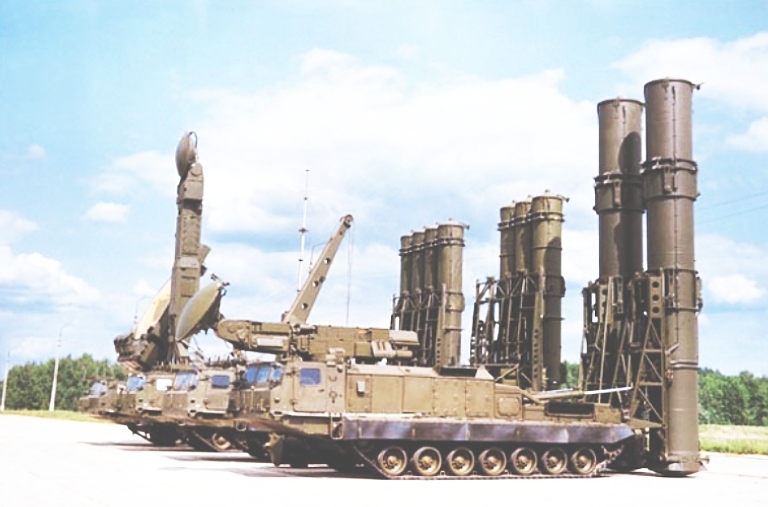 The Antey S-300V / SA-12 was the first fully mobile SAM system tasked with a counter ISR role. The hypersonic 9M82M Giant missile can engage targets at 110 NMI range.
9A82
TELAR Deployed
9M82
Giant SAM
The first mobile weapon developed for this purpose was the Army PVO-SV Antey S-300V system, armed with the 9M82/SA-12A Giant long range SAM. This hypersonic missile was designed to intercept ballistic missiles or aircraft in an envelope between 3,200 ft AGL to 100 kft, and ranges of 7 to 54 nautical miles. The system is supported by two X-band phased array engagement radars, the 9S32 Grill Pan and 9S19 High Screen, and all elements are fully mobile on MT-LB tracked chassis. By the 1990s, Antey extended the performance of the 9M82 series with the extended range 9M82M missile as part of the S-300VM system, also marketed as the Antey 2500. This missile could engage aircraft at 110 NMI range.
5V28E
/ SA-5
Gammon: The S-200
Gammon system using the 5V28 SAM and 5N62 Square Pair radar could
engage airborne targets at 160 NMI and was the first SAM system tasked
with a counter ISR role.
5N62
Square
Pair (http://www.fortifikace.net) 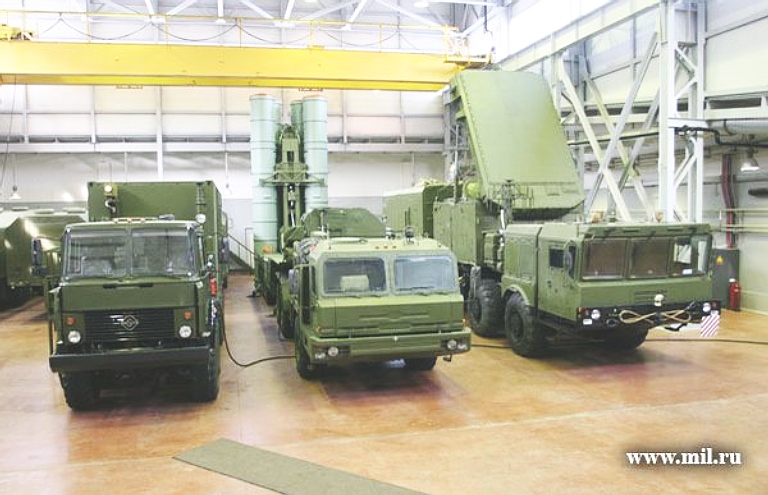 The
S-400
Triumf with its 215 NMI range 48N6DM SAM is the latest Russian mobile
SAM system developed with a counter ISR role. Depicted an S-400 TEL, 30N6E3 engagement
radar and command van.
64N6E
Deployed
With the progressive replacement of the S-200D systems during the 1990s with the newer Almaz S-300PMU-1/2 / SA-10 Grumble series, and more recently the S-400 Triumf / SA-20 Gargoyle system, the Russians developed an extended range variant of the established 48N6 series are defence missile. The 48N6DM is credited with a range of 215 NMI against high flying targets, and can be fired by late model S-300PMU-2 and S-400 batteries. The fully mobile battery is typically supported by a late variant of the 30N6E2 Flap Lid X-band engagement radar and the C-band 64N6E2 Big Bird acquisition radar. Both radars are phased arrays, with the 64N6E2 Big Bird comparing closely in performance and capabilities with the SPY-2 Aegis radar. China is the principal export customer for the S-300PMU series. Summary The emergence of long range counter ISR missiles, be they air launched or SAMs, is one of the most important technological developments of the last decade. These weapons afford their users the opportunity to deny airspace to high flying ISR platforms, be they manned AWACS/AEW&C, JSTARS or ELINT/SIGINT aircraft, or UAVs such as the RQ-4 Global Hawk series. If a launch system can get within 200 NMI of the ISR asset, it gains a firing opportunity. The notion that these weapons can be arbitrarily dismissed as a factor in strategic planning for this region is not reasonable. Counter ISR missiles are the big equaliser, and can be expected to be widely deployed across Asia over coming years. |
Imagery Sources: US DoD, Russian MoD, MilitaryPhotos.net; other Internet sources. |
|
Technical Report APA-TR-2007-0707 |
|
|||||||||||||
![Sukhoi PAK-FA and Flanker Index Page [Click for more ...]](APA/flanker.png) |
![F-35 Joint Strike Fighter Index Page [Click for more ...]](APA/jsf.png) |
![Weapons Technology Index Page [Click for more ...]](APA/weps.png) |
![News and Media Related Material Index Page [Click for more ...]](APA/media.png) |
||||||||||
![Surface to Air Missile Systems / Integrated Air Defence Systems Index Page [Click for more ...]](APA/sams-iads.png) |
![Ballistic Missiles and Missile Defence Page [Click for more ...]](APA/msls-bmd.png) |
![Air Power and National Military Strategy Index Page [Click for more ...]](APA/strategy.png) |
![Military Aviation Historical Topics Index Page [Click for more ...]](APA/history.png)
|
![Information Warfare / Operations and Electronic Warfare Index Page [Click for more ...]](APA/iw.png) |
![Systems and Basic Technology Index Page [Click for more ...]](APA/technology.png) |
![Related Links Index Page [Click for more ...]](APA/links.png) |
|||||||
![Homepage of Australia's First Online Journal Covering Air Power Issues (ISSN 1832-2433) [Click for more ...]](APA/apa-analyses.png) |
|||||||||||||
| Artwork, graphic design, layout and text © 2004 - 2014 Carlo Kopp; Text © 2004 - 2014 Peter Goon; All rights reserved. Recommended browsers. Contact webmaster. Site navigation hints. Current hot topics. | |||||||||||||
|
Site Update
Status:
$Revision: 1.753 $
Site History: Notices
and
Updates / NLA Pandora Archive
|
|||||||||||||
|
|
Tweet | Follow @APA_Updates | |||||||||||
|
|
|||||||||||||
|
|
|||||||||||||
![F-111 Aardvark Index Page [Click for more ...]](APA/f-111.png)
![F/A-18 Hornet and Super Hornet Index Page [Click for more ...]](APA/fa-18a.png)
![Aerial Refuelling and Airlift Capabilities Index Page [Click for more ...]](APA/aar-lift.png)
![Directed Energy Weapons and Electromagnetic Bombs Index Page [Click for more ...]](APA/dew.png)
![Notices and Updates Index Page [Click for more ...]](APA/notices-128.png)
![APA NOTAM and Media Release Index Page [Click for more ...]](APA/notams-128.png)
![APA Research Activities and Policy / Technical Reports Index [Click for more ...]](APA/research-128.png)
![Search Air Power Australia Website [Click for more ...]](APA/search-128.png)
![Briefings and Submissions - Air Power Australia [Click for more ...]](APA/briefs-128.png)
![Air Power Australia Contacts [Click for more ...]](APA/contacts-128.png)
![Funding Air Power Australia [Click for more ...]](APA/funding-258.png)
